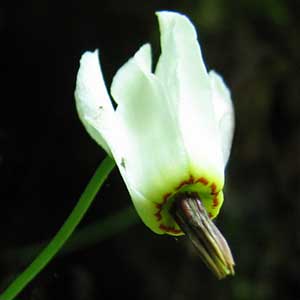Dodecatheon dentatum
Dodecatheon alpinum
dentate shooting star, tooth American cowslip, white shooting star
alpine shooting star
not obvious at anthesis, or sometimes erect to slightly horizontal, slender;
roots white or reddish;
bulblets absent.
not obvious at anthesis or short and compact;
root whitish;
bulblets absent.
(3.5–)8–20(–30) × (1–)2.5–6(–7) cm;
petiole slightly winged;
blade ovate, base decurrent onto stem, abruptly tapering to petiole, margins subentire to sinuate or crenate, surfaces glabrous.
2–20(–27) × (0.3–)0.5–2(–3.5) cm;
petiole winged;
blade linear to linear-oblanceolate, base decurrent onto stem, gradually tapering to petiole, margins entire or nearly so, surfaces glabrous.
(1–)2–5(–11)-flowered;
bracts lanceolate, 1.5–5(–8) mm, glabrous.
1–10-flowered;
bracts lanceolate, 3–10(–12) mm, usually glabrous, sometimes sparsely glandular-puberulent.
0.8–5 cm, glabrous.
(0.5–)1–5 cm, usually glabrous, rarely sparsely glandular-pubescent.
calyx light green, 4–6 mm, glabrous, tube 2–3.5 mm, lobes 5, 1.5–3(–4) mm;
corolla tube yellow with red, thin, wavy ring, lobes 5, white, 7–18(–20) mm;
filaments distinct, maroon to black, 0.1–0.5 mm;
anthers (4.5–)5–7.5 mm;
pollen sacs maroon to black, connective dark purple to maroon, smooth;
stigma not enlarged compared to style.
calyx greenish and finely purple-flecked, 5–9.5(–10) mm, usually glabrous, rarely sparsely glandular-puberulent, tube 1–3(–4) mm, lobes 4, (2–)4–7(–8) mm;
corolla tube yellowish with purplish red, thin, wavy ring, lobes 4, usually magenta to lavender, rarely pink or white, (6–)8–20 mm;
filaments distinct, black, 0.2–0.5(–1) mm;
anthers 4.5–8.5 mm, (apex truncate to obtuse);
pollen sacs purple and often mottled, connective dark purple, transversely rugose;
stigma enlarged, diam. usually 2+ times style.
pale greenish to tannish, dark yellow apically, valvate, narrowly ovoid, (6–)8–11 × 3–5 mm, glabrous;
walls thin, pliable.
tan to light brown, often purplish toward apex, valvate, narrowly ovoid, 5–11(–12) × 3–7 mm, glabrous;
walls thin, pliable.
without membrane along edges.
with membrane along edges.
= 44.
= 44.
Dodecatheon dentatum
Dodecatheon alpinum
Dodecatheon dentatum occurs mainly on the eastern slope of the Cascade Range from south-central British Columbia to central Washington, with disjunct populations near the Columbia River in southwestern Washington, the Columbia River Gorge, northeastern Oregon, and northern Idaho. In Idaho, this species occasionally forms hybrids with D. pulchellum var. pulchellum (Oberle 262, MO).
(Discussion copyrighted by Flora of North America; reprinted with permission.)
Dodecatheon alpinum is found in widely scattered locations in the San Jacinto Mountains, Transverse Ranges, Sierra Nevada, northern coastal ranges, and the Siskiyou Mountains of California, southwestern Oregon, and west-central Nevada, and in the Cascade Ranges to just north of the Columbia River in Skamania and Yakima counties of Washington. It may be seen on scattered basin ranges in the Intermountain West of Nevada (e.g., East Humboldt, Jarbidge, Ruby, Snake) and western Utah (Deep Creek Mountains), and in some desert ranges of southern Oregon as far east as the Steens Mountains in Harney County; it is disjunct to the Blue and Wallowa mountains of northeastern Oregon. There are other disjunct populations in the northern Wasatch and Uinta mountains of northern and northeastern Utah, and even more widely scattered populations in the southern Wasatch and Tushar mountains. The species has also been found at Warm Springs in Millard County. Isolated populations occur on the Pine Valley Mountains, Utah, and around the Grand Canyon and Mogollon Rim areas of Arizona as far south as Greenlee County.
Narrow-leaved plants that are sparsely glandular-pubescent are sometimes found at higher elevations in the Sierra Nevada, making a distinction between Dodecatheon alpinum and D. jeffreyi occasionally arbitrary. A specimen from Deschutes County, Oregon (C. L. Hitchcock and J. S. Martin 4919, UTC, WTU) has leaf blades to 3.5 cm wide.
(Discussion copyrighted by Flora of North America; reprinted with permission.)
